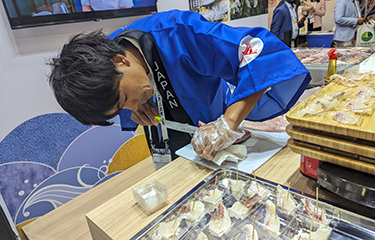The release of treated wastewater from the damaged Fukushima Daiichi Nuclear Power Station has some Japanese companies fearing the long-term impacts of the decision.
Tokyo Electric Power Company Holdings (TEPCO) had been planning to release the water for years, and regulatory authorities finally gave the go-ahead in August, offering assurance it would cause no harm to sea life or the ocean. Despite those assurances, purported concerns about food safety led China to ban imports from Japan, and Japanese officials met to eat seafood from the area in a bid to stress the safety of seafood caught in Japanese waters.
At Seafood Expo Asia, which ran from 11 to 13 September in Singapore, the issue was top of mind for Japanese companies and organizations in attendance.
For Hokkaido scallop producers such as Uda Takanori of the Dogyoren firm, there has been a direct impacts due to customers pulling back orders, though less than Takanori feared.
Takanori told SeafoodSource that in talking with other exhibitors from Japan at Seafood Expo Asia, he heard of widespread order cancellations in response to the release.
As some customers pull back, Takanori said Dogyoren is looking to sell diversify its customer base.
“Instead of selling to China, we are aiming to sell to new markets in Southeast Asia, and to expand the domestic market in Japan,” Takanori said.
Some of the Japanese vendors attending the expo told SeafoodSource that they expect no effects at all from the wastewater release.
“Our situation is very different from the Fukushima area,” Re:Blue CFO Fumiaki Ando told SeafoodSource. “We don’t have any influence from Fukushima."
Japan’s coastal waters, Ando said, flow from the south to the north, and due to Fukushima’s location in the north of Japan, the company’s oyster farms will likely never see any impacts from the released water.
Japan Farmed Fish Export Association Ei Kiuchi told SeafoodSource his group is similarly situation, with much of its fish caught in warmer southern waters. However, the association recognizes that it will still be affected negative public perception, as consumers conflate Japanese seafood as a whole with seafood from the Fukushima region.
“Most of the Japanese believe that the water is no problem, and we can consume and eat seafood as normal,” Kiuchi said. “But of course, there are those who are worried, and I think some fishermen do not agree with the release because they are worried about the bad reputation.”
Kiuchi said the global market for yellowtail is largely dominated by the U.S., not China, so its ban is less of a problem.
“We think Southeast Asia has a very high potential, and we want more and more customers to understand and recognize the taste of Japan,” she said.
Hiroto Nichimori with the Kochi Seafood Export Promotion Association said it was his feeling there is little domestic concern over seafood safety due to the release.
“I think Japanese people don’t care. We believe in our government,” Nichimori told SeafoodSource. “Our government has already inspected the water, and they say it’s okay.”
However, Nichimori acknowledged the heightened concerns prevailing elsewhere in Asia.
“What I’m more worried about is the other part of the world, their reaction,” Nichimori said. “What I think is the government should make sure that the other parts of the world will believe the government. They have to believe that our seafood is safe enough to eat.”
Nichimori said the situation mirrors the one that confronted Japan's seafood industry after the original earthquake and tsunami that caused the Fukushima disaster, after which many countries instituted bans on Japanese seafood, only to later rescind them.
“Gradually, they believe in the safety of Japanese products,” Nichimori said.
That took two or three years, however, and Nichimori said the country needs to make an effort to speed up that process this time around, as the industry is struggling due to a crash in demand from Hong Kong, Macau, and China.
Chinese seafood imports from Japan dropped 67 percent year over year in August, according to data from China's General Administration of Customs, reaching USD 20.4 million (EUR 19.1 million).
Photo by Chris Chase/SeafoodSource







